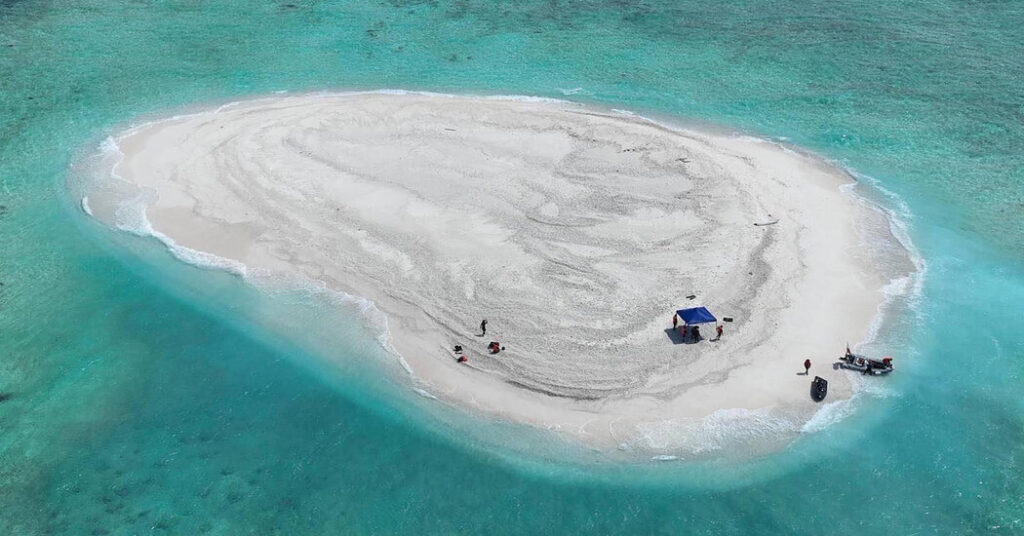A small sandbar in the contested South China Sea has emerged as a new point of tension between China and the Philippines, with both nations displaying their flags to assert their claims over the territory.
Earlier this month, Chinese Coast Guard personnel landed on the disputed Sandy Cay reef, raised their national flag, and asserted their “sovereign jurisdiction,” according to Chinese state news reported on Thursday.
By Sunday, after they had left, the Philippines sent its own personnel to the sandbar. In response, Beijing labeled the Philippines’ actions as “illegal boarding,” insisting it holds “indisputable sovereignty” over the Spratly Islands, a group of numerous small islets, including Sandy Cay, in the South China Sea and its waters.
This standoff follows the start of the annual joint military exercises between the United States and the Philippines, which China has criticized as threatening to regional stability. The United States, a treaty ally of the Philippines, has committed to assist Manila in the event of an attack.
China’s broad claims in the South China Sea have led to heightened tensions for many years. The country has significantly increased its military presence in the Spratlys, establishing a military base on reclaimed land around Subi Reef, which is close to Thitu Island, the Philippines’ key military outpost in the Spratlys.
Some analysts believe that China may be trying to gain control over Sandy Cay — a small area of 200 square meters (approximately 2,150 square feet) — to strengthen its claim over Subi Reef, parts of which are submerged during high tide.
“Even if they create an artificial island, there isn’t a territorial sea,” stated Antonio Carpio, a former Supreme Court justice who played a role in the Philippines’ successful international case against China’s claims in the South China Sea. “Their only chance to legitimize their claim is to control Sandy Cay.”
Euan Graham, a senior analyst at the Australian Strategic Policy Institute, noted that recent actions indicate a change in China’s tactics in the South China Sea.
“Instead of heavily fortifying with concrete or deploying the PLA,” Mr. Graham explained, “they’re staging flag-raising events, quickly disembarking and asserting sovereignty while gauging reactions. Interestingly, the Philippines mirrored this approach almost immediately.”
He added, “The crucial question is, how will the U.S. respond? Will they support their ally if tensions escalate, or will they decide, ‘No, we won’t engage in conflict over a trivial piece of sand?’”
On Monday morning, Jonathan Malaya, the assistant director general of the Philippines’ National Security Council, rejected China’s assertion that it had taken control of the reef and urged restraint to avoid escalating tensions in the South China Sea.
“It’s not beneficial for any nation for these incidents to occur, nor is it helpful for irresponsible statements and declarations to be made to the public and the world,” he stated to reporters.
Beijing claims nearly 90% of the South China Sea, overlapping with claims from Vietnam, Malaysia, Brunei, Indonesia, and the Philippines. Notably, the Philippines has taken a leading role in the territorial disputes, asserting that Chinese vessels have obstructed access to crucial fishing and energy resources within its exclusive economic zone.
These tensions have intensified significantly in recent years, increasing the likelihood that the U.S. could become involved in a conflict.
Both China and the Philippines have shared images of their flags being raised on the reefs. Chinese state broadcaster CCTV even released a photo of four individuals standing on the uninhabited reef.
Jay Tarriela, spokesperson for the Philippines Coast Guard, informed reporters that officials had been deployed to determine if the Chinese government had erected any structures or monitoring equipment on Sandy Cay but found none. However, he noted that a Chinese Coast Guard vessel and seven maritime militia vessels were still situated near the island.


